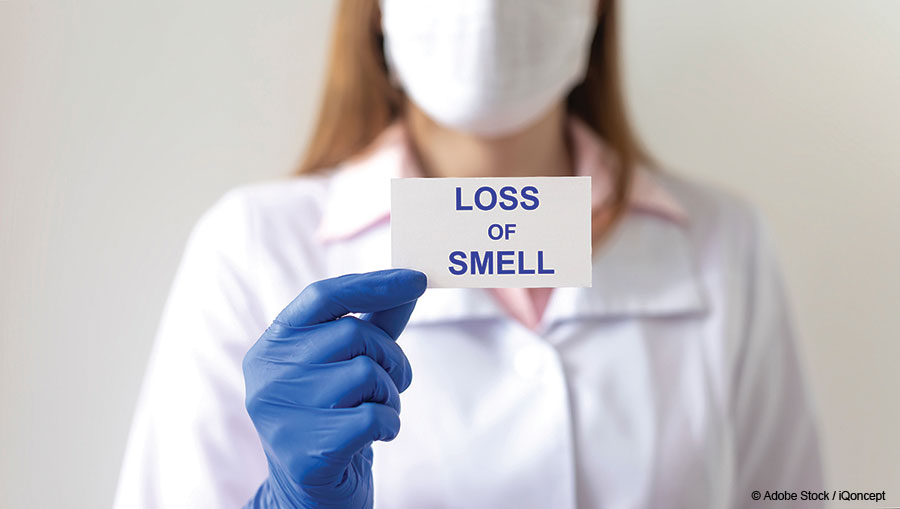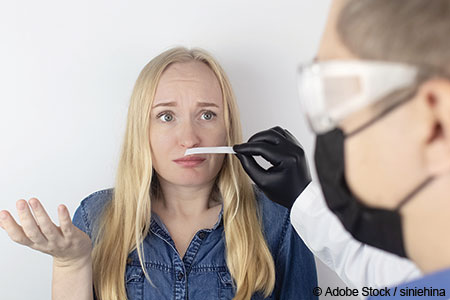 More than 13 million U.S adults live with measurable smell dysfunction, according to the National Institute on Deafness and Other Communication Disorders (NIDCD. https://tinyurl.com/2jy4vdv7).
More than 13 million U.S adults live with measurable smell dysfunction, according to the National Institute on Deafness and Other Communication Disorders (NIDCD. https://tinyurl.com/2jy4vdv7).
Explore This Issue
March 2025That’s one in eight adults over the age of 40—and that’s likely a low estimate because it’s based on a 2016 report that was released well before the COVID-19
pandemic affected the olfactory capabilities of millions, raising global awareness about the morbidity of smell and taste dysfunction (Rev Endocr Metab Disord. doi:10.1007/s11154-016-9364-1).
That awareness is fueling scientific advances.
“One of the consequences of so many people losing their sense of smell during the pandemic is that there is a renewed interest in developing treatments for patients with smell disorders,” said Bradley Goldstein, MD, PhD, a professor of head and neck surgery, cell biology, and neurobiology at Duke University in Durham, N.C.
Scientists know less about our senses of smell and taste than the senses of hearing, vision, and touch. That’s in part because the location of the olfactory bulbs makes them difficult to access and in part due to the complexity of the olfactory system.
“I would say we’re still in the infancy of really understanding the disease processes underlying smell and taste dysfunction, and therefore in the infancy of coming up with treatment options,” said Zara Patel, MD, professor of otolaryngology–head and neck surgery at Stanford Medicine in Stanford, Calif.
Although researchers have made significant strides in understanding the basics of olfaction, they are still working to untangle the pathophysiology that drives olfactory dysfunction.
We still don’t understand mechanistically why smell loss happens…It’s much harder to come up with a fix when we’re still trying to figure out exactly where it got broken. — Justin Turner, MD, PhD
“We still don’t understand mechanistically why smell loss happens,” said Justin Turner, MD, PhD, chair of the department of otolaryngology at the University of Alabama–Birmingham Marnix E. Heersink School of Medicine. “In the case of post-viral infection smell loss, is it the virus itself that kills cells, or is it the secondary inflammation that occurs due to the viral infection that causes loss of olfactory neurons? Or is it the inability of those neurons to regenerate themselves after their loss?”
This lack of understanding has hampered the development of effective treatments for anosmia, parosmia, and phantosmia. “It’s much harder to come up with a fix when we’re still trying to figure out exactly where it got broken,” Dr. Turner said.
Patients and clinicians alike may experience frustration with persistent, seemingly intractable smell alterations. But although “there’s this sense that there is not a lot we can do for these patients, we can do a fair amount now to help people who have problems with their sense of smell,” Dr. Goldstein said. “The science may not be advancing as quickly as we would like, but there have been some significant advances.”
Advances in Diagnostic Approaches
It is important not to ignore, discount, or minimize patients’ concerns regarding their senses of smell and taste. It’s true that many people eventually regain olfactory function over time, particularly if their smell or taste dysfunction was triggered by a time-limited illness, such as a viral infection. But “when a patient comes in and says, ‘I can’t smell,’ that’s deserving of further evaluation and investigation,” Dr. Turner said. “Typically, if a patient is mentioning it, it’s having a negative impact on their quality of life.”
 The assessment and diagnostic process should include a thorough history, both to determine possible etiologies of olfactory dysfunction and to understand how patients’ altered sense of taste or smell is affecting their nutrition, socialization, and safety. Objective smell testing is also recommended, even though private insurance and Medicare don’t reimburse for smell tests or pay for the time and expertise it takes to administer the test and educate patients about smell testing (WHYY. https://tinyurl.com/ybvupwh7).
The assessment and diagnostic process should include a thorough history, both to determine possible etiologies of olfactory dysfunction and to understand how patients’ altered sense of taste or smell is affecting their nutrition, socialization, and safety. Objective smell testing is also recommended, even though private insurance and Medicare don’t reimburse for smell tests or pay for the time and expertise it takes to administer the test and educate patients about smell testing (WHYY. https://tinyurl.com/ybvupwh7).
A variety of smell tests are currently available. Sniffin’ Sticks, a standardized olfactory function test, was developed in Germany in 1997 (Eur Ann Otorhinolaryngol Head Neck Dis. doi.org/10.1016/j.anorl.2015.08.004); it has since been validated in many countries and settings, but it’s impractical for routine use, as testing takes approximately 45 minutes (Chem Percept. doi.org/10.1007/s12078-021-09287-2). Two newer tests include SCENTinel 1.1, developed by researchers at the Monell Chemical Senses Center, and U Smell It, a test developed by Derek Toomre, PhD, a Yale professor of cell biology (usmellit.com). Both tests can be self-administered in minutes. The SCENTinel test card contains three “Lift’nSmell” patches and measures an individual’s ability to detect an odor, estimate the odor’s intensity, and identify it. Research to date suggests that SCENTinel is reliable and accurate in a variety of settings—and can detect parosmia (Chem Senses. doi.org/10.1093/chemse/bjab004). U Smell It has two parts: U Smell It training and test cards, with defined scratch-and-sniff areas, and an associated digital app, which individuals use to enter their responses and receive their scores. U Smell It is U.S. Department of Food and Drug Administration certified as a Class 2 exempt medical device.
Objective smell tests are helpful for both patients and clinicians. “Many times, when folks come in reporting really severe smell loss, objective testing may show that their sense of smell isn’t that bad,” Dr. Turner said. “That information may alleviate some of their concerns and give them hope that, over time, their senses will return to normal.”
People typically think their sense of smell is better than it is, particularly in the geriatric population. — Carol Yan, MD